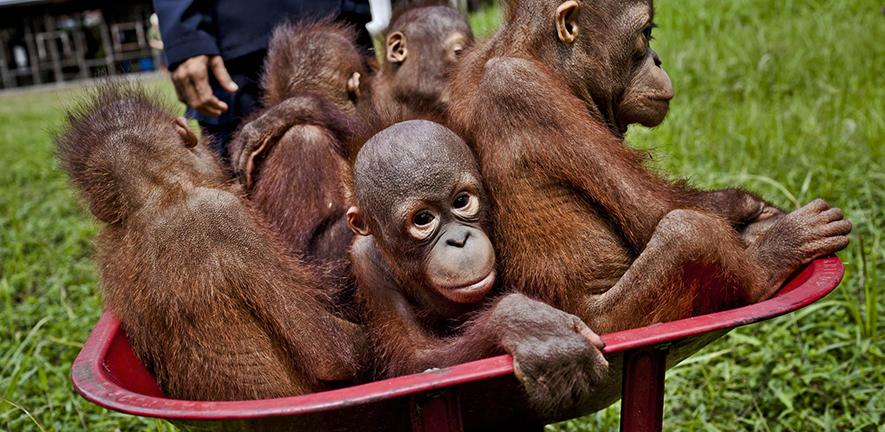Nov 9 2020
According to new research, birds, amphibians, and mammals around the world have lost, on average, 18% of their natural habitat range due to variations in land use and climate change.
 Baby orangutans in Central Kalimantan. Expansion of oil palm plantations is destroying their forest habitat. Image Credit: Ulet Ifansasti/Greenpeace.
Baby orangutans in Central Kalimantan. Expansion of oil palm plantations is destroying their forest habitat. Image Credit: Ulet Ifansasti/Greenpeace.
In the hardest case, this loss could rise to 23% over the next eight decades.
The study was recently published in the Nature Communications journal and investigated variations in the geographical range of 16,919 species varying from 1700 to the present day. Also, the data were utilized to forecast changes in the future up to the year 2100 under 16 different climate and socio-economic scenarios.
A varied abundance of species forms the basis of important ecosystem functions right from carbon storage to pest regulation. The susceptibility of species to extinction is strongly affected by their geographical range size. Thus, effective conservation approaches necessitate better insights into how ranges have altered in the past, and how they will vary under alternative future scenarios.
The habitat size of almost all known birds, mammals and amphibians is shrinking, primarily because of land conversion by humans as we continue to expand our agricultural and urban areas.
Dr Robert Beyer, Study First Author, Department of Zoology, University of Cambridge
Certain species are more extensively affected compared to others. A disturbing 16% of species have lost more than half of their calculated natural historical range, and this figure could increase up to 26% by the end of the 21st century.
The geographical ranges of the species were discovered to have recently diminished most considerably in the tropical areas. About five decades ago, a majority of the agricultural development was carried out in Europe and North America.
From that time, huge areas of land have been transformed for agricultural purposes in the tropics—for example, clearing up of rainforest for oil palm plantations in South East Asia and pastureland in South America.
Since the activities of humans are moving deeper into the tropics, the impact on species ranges is turning out to be abnormally larger due to the higher species richness in these areas and because the natural ranges of these species are smaller to start with.
The tropics are biodiversity hotspots with lots of small-range species. If one hectare of tropical forest is converted to agricultural land, a lot more species lose larger proportions of their home than in places like Europe.
Dr Robert Beyer, Study First Author, Department of Zoology, University of Cambridge
The study findings forecast that climate change will have a huge effect on the geographical ranges of the species.
Varying rainfall patterns and increasing temperatures will change habitats considerably, for instance: other studies have forecasted that in the absence of climate action, huge parts of the Amazon might transform from canopy rainforest to a savannah-like mix of woodland and open grassland in the next 10 decades.
Species in the Amazon have adapted to living in a tropical rainforest. If climate change causes this ecosystem to change, many of those species won’t be able to survive - or they will at least be pushed into smaller areas of remaining rainforest.
Dr Robert Beyer, Study First Author, Department of Zoology, University of Cambridge
Beyer added, “We found that the higher the carbon emissions, the worse it gets for most species in terms of habitat loss.”
The findings offer quantitative support for policy measures with the target of restricting the global area of agricultural land—for instance, through the sustainable increase of food production, promoting dietary changes towards eating less meat and stabilizing population growth.
The transformation of natural vegetation to agricultural and urban land and the conversion of appropriate habitat due to climate change are significant reasons for the decrease in range sizes, and two of the most essential threats to global terrestrial biodiversity.
“Whether these past trends in habitat range losses will reverse, continue, or accelerate will depend on future global carbon emissions and societal choices in the coming years and decades,” stated professor Andrea Manica from the University of Cambridge’s Department of Zoology, who led the study.
Manica added, “While our study quantifies the drastic consequences for species’ ranges if global land use and climate change are left unchecked, they also demonstrate the tremendous potential of timely and concerted policy action for halting—and indeed partially reversing—previous trends in global range contractions. It all depends on what we do next.”
Journal Reference:
Beyer, R M & Manica A (2020) Historical and projected future range sizes of the world’s mammals, birds, and amphibians. Nature Communications. doi.org/10.1038/s41467-020-19455-9.